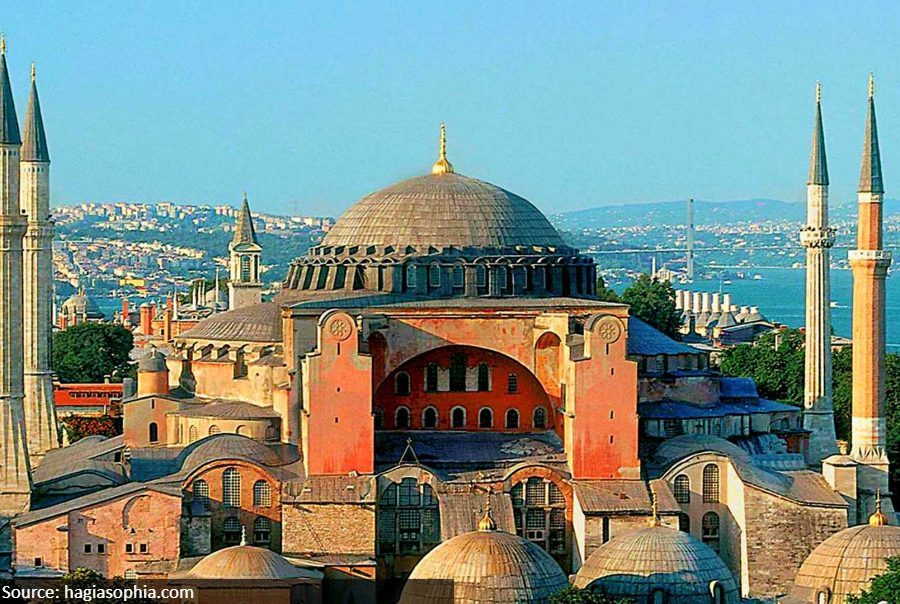Hagia Sophia
Share this attraction
Back

Hagia Sophia
Istanbul
Hagia Sophia - most important information
Hagia Sophia is the most recognizable landmark in Istanbul and the whole of Turkey. This Byzantine monument represents the religious changes over the centuries in this region. Primarily built as a Christian church, it was changed into a mosque, and then into a museum. Finally, in the year 2020, Hagia Sophia again become a mosque. It was built in 537 by the order of the Byzantine emperor Justinian I.
History of Hagia Sophia
Two churches were demolished at the spot where today stands Hagia Sofia. But the one we can still see in Istanbul was built by the order of the Byzantine emperor, as the Cathedral of the Ecumenical Patriarchate of Constantinople. But this building has seen many changes. Between 1204 and 1261 served as a Catholic church, and then, in 1453, was made into a mosque. This is owed to Mehmed II who conquered Constantinople under the Turkish flag. Of course, in order to become a real mosque, a minaret, chandelier, mihrab, and a minbar had to be added to the church. Today, there are four minarets, all erected by different sultans. And this was the church’s faith for the next five centuries. Finally, in 1931, Hagia Sophia became a museum. This was ordered by Kemal Atatürk, the founder, and the first president of the Republic of Turkey. The whole building became a component of the UNESCO World Heritage Site. In 2020, the current president of Turkey, Recep Tayyip Erdoğan made a decision to make the Hagia Sophia mosque again. This was an unexpected decision, but since many tourists still come to Istanbul to see this beauty, it is open for visitors.
What to see in Hagia Sophia?
This building is a landmark of the rich and turbulent history of Constantinople and today’s Istanbul. The whole building of Hagia Sophia is outstanding, and you should see it from every perspective, and, of course, get inside.
- The architecture - Get around the mosque and see all its walls and minarets. You will see the mixture of different cultures and religions built together in one historical monument.
- The dome - This dome is considered one of the greatest examples of Byzantine architecture. Because of its size, it is supported on pendentives and two semidomes. This type of construction was unique and was the inspiration for many future architects.
- Mosaics - Many Christian mosaics are left from the time this was a church. They all represent saints, angels, Jesus Christ, and representations from the Bible.
- Muslim ornaments - In the Muslim religion, temple interiors are decorated in writings from the Koran. The same is with Hagia Sophia. Alongside Christian mosaics stand numerous Muslim ornaments and writings on the walls.
- Tombs - This mosque is eternal rest for many Turkish sultans. The tombs of Sultan Mehmed III, Sultan Mustafa I, Sultan Selim II, Sultan Murat III and the tomb of princes.
Tickets and Opening Hours
- Opening hours - Opening hours are between 09:00 in the morning and 17:00 in the evening. Nevertheless, keep in mind the praying hours. Also, the mosque closes one hour before the prayer and opens half an hour after the prayer.
- Tickets - Since Hagia Sophia became a mosque, there is no entrance fee.
How to get to Hagia Sophia?
If you're coming from Taksim Square, the city's main square, you can ride the F1 Funicular to Kabatas. In Taksim Square, the F1 funicular is located inside the metro station. From Kabatas Tram Station, take Tram T1 to Sultanahmet. This will take you around 15 minutes.
What should you know before visiting
- Dress code - Since Hagia Sophia is now a mosque, there is a new dress code introduced to visitors. You have to wear a headscarf when entering the mosque and wearing shorts is banned.
- Best time to visit - We recommend you to visit Hagia Sophia around 9 am, when no prayers are held and when the place is less crowded.
Hagia Sophia trivia
- Hagia Sophia changed its name over time. It was first known as the Great Church and later got its name that we all know today. Hagia Sophia means holly wisdom in Greek.
- Many mosaics in Hagia Sophia were destroyed, removed, or plastered over during the time of iconoclasm.
- In the northwest portion of the church stands the column that is known as the Weeping column, because of the small hole in it that and is damp to the touch. Many people believe that touching this liquid has healing powers.
- The Hagia Sophia was built with columns from the long-abandoned and ruined Temple of Artemis in Ephesus to reinforce and decorate the interior of the church. This basically means that Hagia Sophia was constructed using one of the seven ancient wonders.
Location
Learn more about this destination
Discover the beauty of the destination through blogs that highlight the most famous landmarks, hidden gems, and provide travel tips for visiting this destination. Embark on an adventure through the stories of experienced travelers.






















